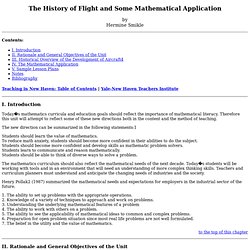

Conrad Wolfram: Teaching kids real math with computers. Arthur Benjamin: Teach statistics before calculus! Dan Meyer: Math class needs a makeover. In Teaching Math, What’s the Right Mix of Content and Context? Teaching Strategies Getty “Polynomial functions!”

“Trig identities!” “How about the properties? Commutative, associative, distributive.” So unfolded a laundry list of what a group of math teachers considered the more painful and less necessary concepts covered in the average high school math curriculum. The laments, aired at EduCon 2.5 in Philadelphia at Science Leadership Academy last weekend, were part of a discussion around how to rebuild math instruction under the radically different—and admittedly unlikely—parameters posed by moderator Mike Thayer, a math teacher at Summit Public Schools in New Jersey. Thayer, who also has a background teaching high school physics, proposed a scenario in which high school freshmen would take a one-year course (or a one-semester course in a block scheduling system) that covered the essentials of Algebra 1 and 2, Geometry, and possibly parts of Trigonometry.
Students the basics of logarithms while covering the pH scale. WHAT STAYS AND WHAT GOES? Related. Logarithms, explained - Steve Kelly. Math Teachers’ Circle Network. The History of Flight and Some Mathematical Application. A.

Developments before the Wright Brothers Men had always wondered why it was impossible for them to attain the art of flying. They questioned the ability of birds to fly. As a result of their fascination for flying, stories of mans ability to fly have been embedded in the Greek myths of Daedalus and his son, Icarus. The stories were centered around his escape from the island of Crete where he was imprisoned. Mans idea about flying was thus centered on the imitation of birds; as a result various medieval people fastened wings to their bodies and tried to fly. (figure available in print form) Finally men gave up the idea of strapping a pair of wings to their bodies to enable them to fly. Leonardo da Vinci designed a number of these. Ornithopters did not accomplish any successful flight; therefore they made no contribution to the advancement of flight. It was not until November 21, 1783 that human efforts to fly were accomplished. He devoted a life of study to aerodynamics.
Alexander F. B. Mathematics Illuminated. These interactives illustrate concepts and give opportunities to test out ideas that have been explored in the units.

Some set up concepts within the units, while others extend them through idealized real-world applications. HELPFUL TIP: These interactives require JavaScript and Flash Player 7. You can download the latest version of Flash Player at Adobe's website. Figurate Numbers Some of the first people to study numbers as objects were the Pythagoreans. This interactive should take 15 - 20 minutes to complete. Shotgun Sequencing Using combinatorics, this interactive looks at the ordering of DNA. This interactive should take 20-30 minutes to complete. Robots Because this interactive covers an abstract concept of configuration space, you may benefit by reading the text chapter first. This interactive should take 30-40 minutes to complete. Hypercube By modeling objects of lower dimensions, you will be able to gain an understanding of the hypercube, which exists in the fourth dimension.
Symmetry.